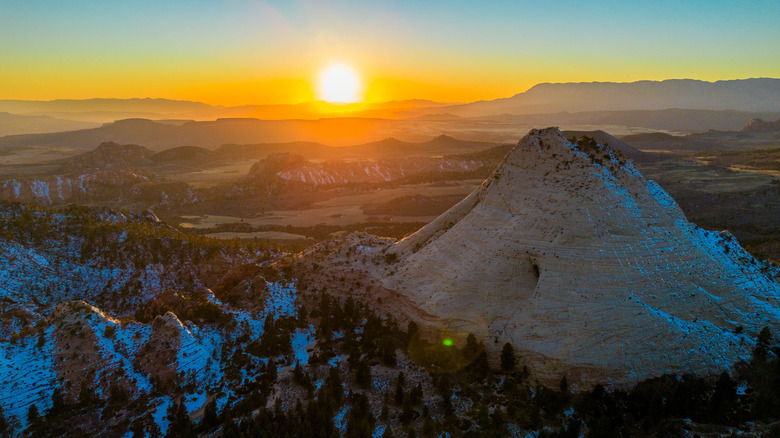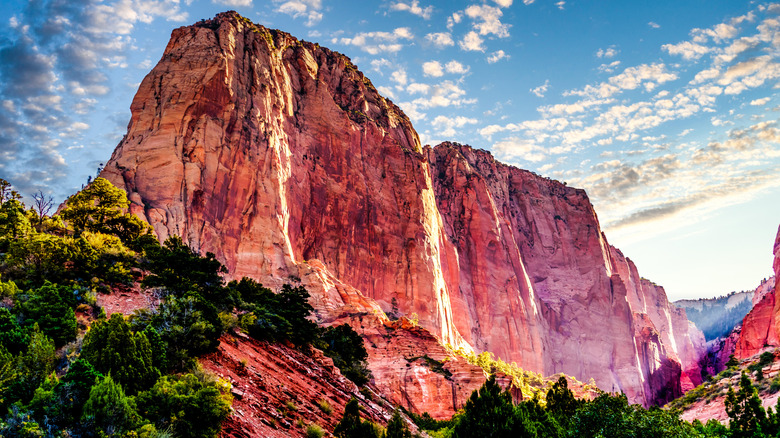Avoid Zion's Crowds On This Rugged Adventure Through The Park's Hidden Gems And Greatest Hits
We may receive a commission on purchases made from links.
Zion is among the most popular of the U.S. national parks, so it's not surprising that visitors looking to immerse themselves in the incredible landscape often plan the trip's timing to avoid the crowds — while still trying to see all the best it has to offer, of course. If you're up for a challenge, the best way to explore Zion National Park might be a particular series of trails, which, when hiked together, are known as the Trans-Zion Trek or the Zion Traverse. This journey is an impressive 51 miles and takes hikers on a diagonal path all the way across the park. If you do the entire trek, you'll get the chance to explore many different areas of Zion National Park, all within less than a week.
Your hikes will go from campsite to campsite, giving you plenty of opportunities to wake up early and see the sun rise over the red rocks. Depending on how fast you want your pace to be, you can technically complete the entire Zion Traverse with just three overnight stays at three different campsites. However, if you want to take your time and explore, then four or five nights may be more your speed. This route includes some of the most iconic parts of the park, but it's also possible to add other hikes onto your journey — including the hugely popular but deadly Angel's Landing hike. The best part of the Trans-Zion Trek? Peace, quiet, and little to no crowds.
What to expect on the trail when you hike the Zion Traverse
If you choose to go west to east on the Zion Transverse, you should expect a gradual upward climb, with an impressive 4,000-foot downward slope right at the end, which takes you straight into the iconic Zion Valley. Along your journey, you'll see some of the park's most famous and beautiful sites: Kolob Canyons, Wildcat Canyon, the West Rim, Zion Canyon, and the East Rim. Until you reach Angel's Landing, it's very likely that you will have a lot of this trail to yourself, so there's no competition for the breathtaking views along the way.
The Trans-Zion Trek isn't actually one trail; it's a route through the park that utilizes multiple established trails, starting with La Verkin Creek Trail, which provides gorgeous vistas of not only Timber Creek but the sheer cliffs around it. You can even detour to the famous Kolob Arch. Next, you'll reach the Hop Valley Trail, which has some of the most impressive red rocks and clear skies in the park.
After a quick jaunt through the long grass along the Connector Trail, you'll arrive at the Wildcat Canyon Trail. Not only is this area extremely tranquil, but you'll be surrounded by sandy landscapes, evergreen forests, and wildflower meadows. Finally, you'll reach the staggering West Rim Trail and take in breathtaking views of rugged mountains before leaving the solitude of the trek behind and descending into Zion Canyon — probably the most popular spot in the park.
The logistics of your Trans-Zion Trek
Before you begin, you'll need to get an overnight backpacking permit for Zion — which can be tricky to secure. Applications open three months in advance, so you'll really have to plan ahead. Part of why this route is less crowded is because the trailheads are so remote. You can hike the Zion Traverse in either direction, but if you don't want to have a physically grueling journey, it's best to hike west to east. That means starting at Lee Pass Trailhead.
The closest airport to Zion National Park is Cedar City Regional Airport, which is only about a half hour from the trailhead — but if you don't have a ride, it may be cheaper to head to Harry Reid International Airport, which is conveniently among America's most affordable airports for travel out West. From there, you can drive a rental car to the park's main visitor center, about two hours away, and from there, book a shuttle with companies like Zion Adventure Company, Red Rock Shuttle, or Zion Guide Hub to take you to the starting trailhead. That way, you'll be able to pick up your car at the end of the trek.
You should make sure to have a map and know how to read it, and even consider bringing some kind of GPS so that you can keep track of where you are at all times. The most challenging thing about this journey is probably the fact that nearly all of it goes through arid desert terrain. Ensuring that you have the means to safely filter natural water sources and that there is plenty of water with you for the times it isn't available is vital. A Sawyer Water Filtration System paired with Iodine tablets may be a good option to guarantee access to safe drinking water.


